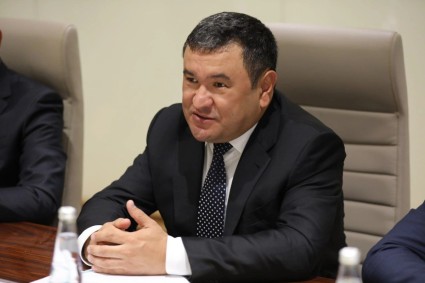Fitch Ratings has upgraded Uzbekistan's Long-Term Foreign-Currency Issuer Default Rating (IDR) to 'BB', from 'BB-' with Stable Outlook.
KEY RATING DRIVERS
Ratings Upgraded: The upgrade reflects accelerated reform progress and favourable medium-term growth prospects, which we expect will contain macrostability risks and continue to drive a sustained improvement in structural credit metrics. These reforms include measures to improve credibility and transmission of monetary policy, advancement of privatisation plans and enhancing transparency of public institutions. Energy tariff liberalisation and subsidy reform contributed to stronger-than-expected fiscal performance in 2024. This is reflected in steady strengthening of governance indicators, although they are still weaker than peers.
The rating continues to reflect low public debt, sizeable external and fiscal buffers and high potential growth, which is balanced by relatively low GDP per capita, high commodity dependence, and still high inflation and financial dollarisation.
Improved Fiscal Position, SOE Reforms: The consolidated budget deficit for 2024 was just over 3% of GDP, better than the authorities' fiscal deficit target of 4% of GDP. This was the result of a broad-based increase in revenues, coupled with halving energy subsidy expenditure to less than 1% of GDP. Fitch expects the deficit to average 3% of GDP in 2025 and 2026, with continued commitment from the authorities to expenditure restraint. Reforms to increase revenue mobilisation could provide an additional buffer.
Reforms to state-owned enterprises (SOEs) have gained momentum, with a further reduction in their number, the transfer of the state's share in 18 SOEs to the National Investment Fund that was set up in August 2024, and reorganisation and restructuring of some large enterprises last year with the objective of improving independence and governance.
Low Government Debt: We forecast government debt-GDP (excluding external guarantees), at about 32% in 2025 and 2026, well below the 'BB' median of about 54%. Nearly 89% of debt is foreign-currency-denominated and a sizeable share is concessional. The average maturity of external debt is just over nine years. Explicitly guaranteed government debt is about 6% of GDP. Based on our estimates, net general government debt, excluding central government deposits, was about 26% of GDP at end-2024 (down from 2019, when it was about -6% of GDP). Unguaranteed SOE external debt was about 5% of GDP and external borrowings for public private partnership projects was about 4% of GDP at end-2024.
Favourable Growth Prospects: We forecast high economic growth in 2025 and 2026 of 6.3% (peer median of 3.8%), broadly in line with 2024, supported by ongoing economic reforms, favourable demand for key commodity exports, particularly gold, and the rising inflow of remittances. Real GDP in 1Q25 grew by 6.8% year on year, boosted by continued strong expansion in services. There is still sizeable economic dependence on Russia, which accounts for about 13.7% of exports, 20.4% of imports and 77% of remittances at end-2024, but Uzbekistan continues to cooperate on enforcement of Western sanctions.
Substantial External Buffers: FX reserves including gold increased to USD49.7 billion at 1 June 2025, from about USD41 billion at end-2024, and we expect reserve coverage of current external payments will be high, at about 10 months over 2025 and 2026, more than double the 'BB' peer median. The increase was largely driven by higher gold prices (gold accounts for nearly 77% of FX reserves), highlighting vulnerability to commodity price changes.
Net External Creditor, Commodity Dependence: Uzbekistan has a relatively large net external creditor position, estimated at about 21% of GDP in 2025. This is down from about 44% in 2020, but remains a strength relative to the 'BB' median. Dependence on commodity exports is relatively high and leaves external finances vulnerable to external shocks. Commodity dependence as a share of current external receipts, was substantial at nearly 30% in 2024. However, the share of services in exports of goods and services has been increasing, with services accounting for about 25% of total exports of goods and services in 2024, up from 14% in 2021.
Inflation Moderating But Still High: The Central Bank of Uzbekistan has continued to phase in inflation targeting and has raised the policy rate by 50bp so far in 2025, to 14%. We expect inflation to slow to an average of 7% in 2026, from about 9% in 2024. This will still be above the central bank's 5% medium-term target. Yearly inflation fell in May 2025, to just below 9% after a high of about 10% in March this year, mainly on the back of lower inflation in services, which make up about 23% of the CPI basket.
Stable Banking Sector: Banking sector profitability is modest, with a return on equity of nearly 7% at end-2024, while the total capital adequacy ratio was around 17%. The regulatory non-performing loan ratio was a low 4% at end-2024, although Fitch estimates the sector's impaired loans under IFRS was close to 10%. Financial dollarisation has been falling, with deposit dollarisation reaching about 24.5% in March 2025, a substantial reduction from about 40% in early 2020. The share of state-subsidised lending in outstanding loans fell further, to 23% in April 2025, from 28% in June 2024, helped by reforms. However, it remains substantial and impairs monetary policy transmission.
ESG - Governance: Uzbekistan has an ESG Relevance Score of '5' for Political Stability and Rights and the Rule of Law, Institutional and Regulatory Quality and Control of Corruption. Theses scores reflect the high weight that the World Bank Governance Indicators (WBGI) have in our proprietary Sovereign Rating Model (SRM). Uzbekistan has a low WBGI ranking at the 28th percentile, reflecting relatively weak rights for participation in the political process, weak institutional capacity, uneven application of the rule of law and a high level of corruption.












